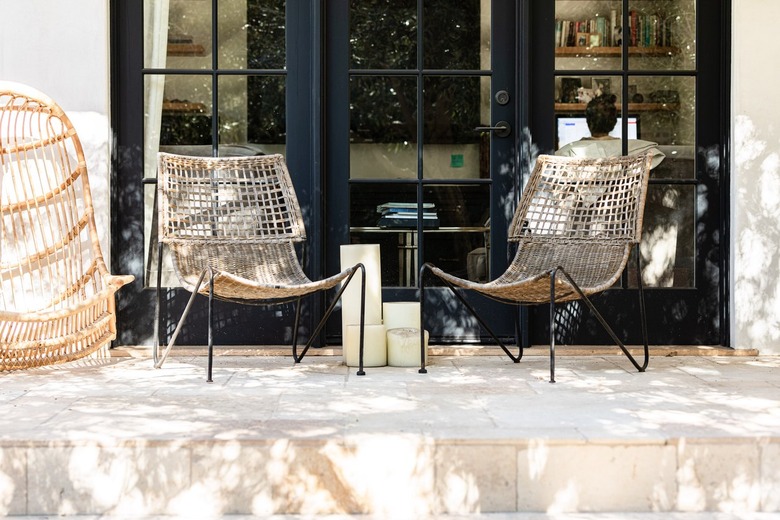Typical Size For A Front Porch
We may receive a commission on purchases made from links.
Personal taste, architectural style, building codes, and other factors can all affect both the size and style of a new front porch. Generally, however, the minimum depth of a front porch is 6 feet. But 8 feet is ideal, and that extra 2 feet can really add to your decorating and porch furniture options. While the depth of the porch enjoys a 6- to 8-foot standard, the width of the porch depends mostly on your needs and the style of the home.
General Size Matters
General Size Matters
The entry doors on most houses open inward, but screen doors often swing out when they open. As a result, your porch should at least be deep enough that you can open the storm door without it hanging off the edge of the porch. Depending on how wide your porch is, this may allow for a potted plant or a nice bench at the most.
If you want a more versatile porch, however, where you can sit and chat with the neighbors or watch a thunderstorm roll in, you'll want a porch that is at least 6 feet deep, but 8 feet is even better. This allows you room to set out some rocking chairs or a porch swing and still have plenty of room to walk around them comfortably. If you plan to dine al fresco on your porch, make sure it's at least 10 feet wide so you have room to comfortably fit a dining table.
While there are specific recommendations for the depth of a porch, width is largely about personal preference and scale. If you want to create designated spaces, such as a sitting area and dining area, you may need to go wider. Consider the size of your home before doing so, however. A small cottage with a massive porch will look overwhelmed, while a large home may look silly with a tiny porch. There aren't necessarily strict rules for scale, but you'll know an out-of-proportion porch as soon as you see one, so plan carefully.
Porch Location and Configuration
Porch Location and Configuration
When planning your porch, give serious consideration to how you intend to use it. If, for example, you want to dine on your porch, make sure you place it where you can easily access it from the kitchen. This may mean wrapping the front porch around the side of the house depending on your home's layout. Consider extras, like ceiling fans and lighting, as these elements are much easier to install during the build than after the fact.
Be aware of the views from your porch as well as how much privacy you'll have. If you want to use the porch in the evening, orient it so that it's not facing the setting sun or plan to install blinds or curtains. Will your porch offer a scenic view, or do you need to angle it or design it so that you're not staring into your neighbor's picture window and looking at their big-screen TV? Consider how a porch will change the dynamic inside your home as well. If, for example, you have a large picture window that lets in lots of natural light, you may want to make sure a porch roof doesn't extend over the window.
Determine how much privacy you want too. If your porch will sit close to the street, elevating it can add some extra privacy, while wide, welcoming steps can still encourage neighborly visits. Building codes may also impact where you can place your porch, so check with them before getting too far into your porch plans.
Building Codes and Porch Design
Building Codes and Porch Design
Speaking of building codes, it's important to both follow them and understand how they can impact aesthetics. Following the codes is important for legal reasons, of course, but it's also important for safety. Porches require beefier construction than decks since they often need to support a floor, furniture, and a roof. Even if you have experience building decks, understand that a porch is a different endeavor.
Building codes may also limit your size and location options. Local law may require you to keep your porch a certain distance from property lines, sidewalks, roads, and other structures. Your homeowners' association may also have some rules to keep a sense of uniformity in the neighborhood, which can limit both the size and placement of your new porch.
During the planning stage, keep in mind that building codes will affect aesthetics, which could impact the design choices you make. Code requires porches that sit 30 inches or higher above the ground to have railings, for example. These railings were once required to be 36 inches tall, but many municipalities have increased the required height to 42 inches. This may affect the type and color of railing you choose. Those seeking privacy may opt for solid panels, while those desiring a more open feel may go for a series of pickets instead.
